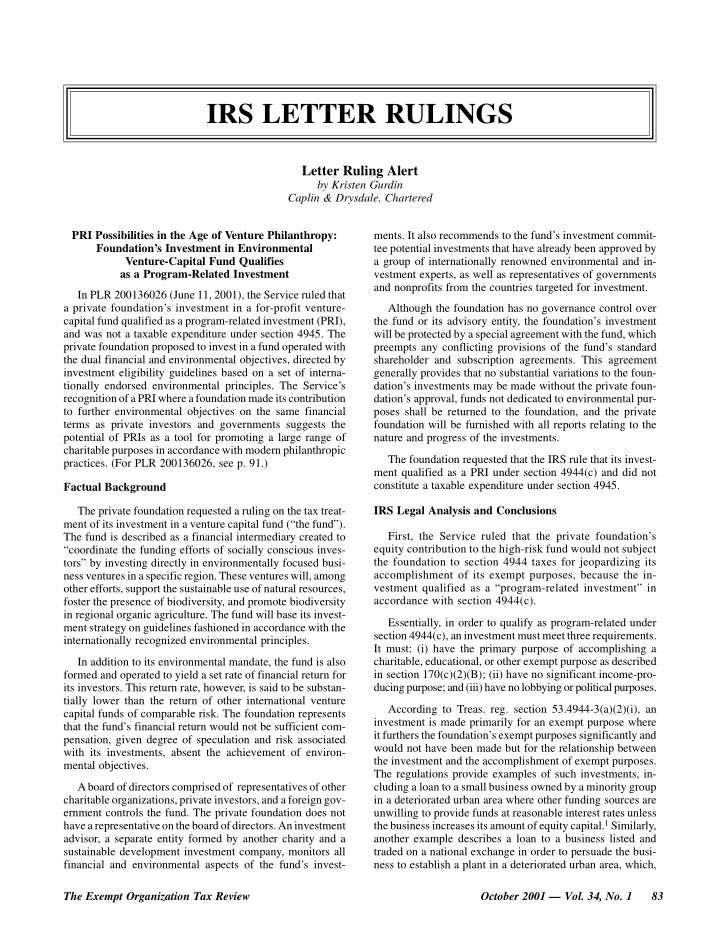



IRS LETTER RULINGS Letter Ruling Alert by Kristen Gurdin Caplin & Drysdale, Chartered PRI Possibilities in the Age of Venture Philanthropy: ments. It also recommends to the fund’s investment commit- Foundation’s Investment in Environmental tee potential investments that have already been approved by Venture-Capital Fund Qualifies a group of internationally renowned environmental and in- as a Program-Related Investment vestment experts, as well as representatives of governments and nonprofits from the countries targeted for investment. In PLR 200136026 (June 11, 2001), the Service ruled that a private foundation’s investment in a for-profit venture- Although the foundation has no governance control over capital fund qualified as a program-related investment (PRI), the fund or its advisory entity, the foundation’s investment and was not a taxable expenditure under section 4945. The will be protected by a special agreement with the fund, which private foundation proposed to invest in a fund operated with preempts any conflicting provisions of the fund’s standard the dual financial and environmental objectives, directed by shareholder and subscription agreements. This agreement investment eligibility guidelines based on a set of interna- generally provides that no substantial variations to the foun- tionally endorsed environmental principles. The Service’s dation’s investments may be made without the private foun- recognition of a PRI where a foundation made its contribution dation’s approval, funds not dedicated to environmental pur- to further environmental objectives on the same financial poses shall be returned to the foundation, and the private terms as private investors and governments suggests the foundation will be furnished with all reports relating to the potential of PRIs as a tool for promoting a large range of nature and progress of the investments. charitable purposes in accordance with modern philanthropic The foundation requested that the IRS rule that its invest- practices. (For PLR 200136026, see p. 91.) ment qualified as a PRI under section 4944(c) and did not constitute a taxable expenditure under section 4945. Factual Background The private foundation requested a ruling on the tax treat- IRS Legal Analysis and Conclusions ment of its investment in a venture capital fund (“the fund”). First, the Service ruled that the private foundation’s The fund is described as a financial intermediary created to equity contribution to the high-risk fund would not subject “coordinate the funding efforts of socially conscious inves- the foundation to section 4944 taxes for jeopardizing its tors” by investing directly in environmentally focused busi- accomplishment of its exempt purposes, because the in- ness ventures in a specific region. These ventures will, among vestment qualified as a “program-related investment” in other efforts, support the sustainable use of natural resources, accordance with section 4944(c). foster the presence of biodiversity, and promote biodiversity in regional organic agriculture. The fund will base its invest- Essentially, in order to qualify as program-related under ment strategy on guidelines fashioned in accordance with the section 4944(c), an investment must meet three requirements. internationally recognized environmental principles. It must: (i) have the primary purpose of accomplishing a In addition to its environmental mandate, the fund is also charitable, educational, or other exempt purpose as described formed and operated to yield a set rate of financial return for in section 170(c)(2)(B); (ii) have no significant income-pro- its investors. This return rate, however, is said to be substan- ducing purpose; and (iii) have no lobbying or political purposes. tially lower than the return of other international venture According to Treas. reg. section 53.4944-3(a)(2)(i), an capital funds of comparable risk. The foundation represents investment is made primarily for an exempt purpose where that the fund’s financial return would not be sufficient com- it furthers the foundation’s exempt purposes significantly and pensation, given degree of speculation and risk associated would not have been made but for the relationship between with its investments, absent the achievement of environ- the investment and the accomplishment of exempt purposes. mental objectives. The regulations provide examples of such investments, in- Aboard of directors comprised of representatives of other cluding a loan to a small business owned by a minority group charitable organizations, private investors, and a foreign gov- in a deteriorated urban area where other funding sources are ernment controls the fund. The private foundation does not unwilling to provide funds at reasonable interest rates unless the business increases its amount of equity capital. 1 Similarly, have a representative on the board of directors. An investment advisor, a separate entity formed by another charity and a another example describes a loan to a business listed and sustainable development investment company, monitors all traded on a national exchange in order to persuade the busi- financial and environmental aspects of the fund’s invest- ness to establish a plant in a deteriorated urban area, which, The Exempt Organization Tax Review October 2001 — Vol. 34, No. 1 83
Recommend
More recommend